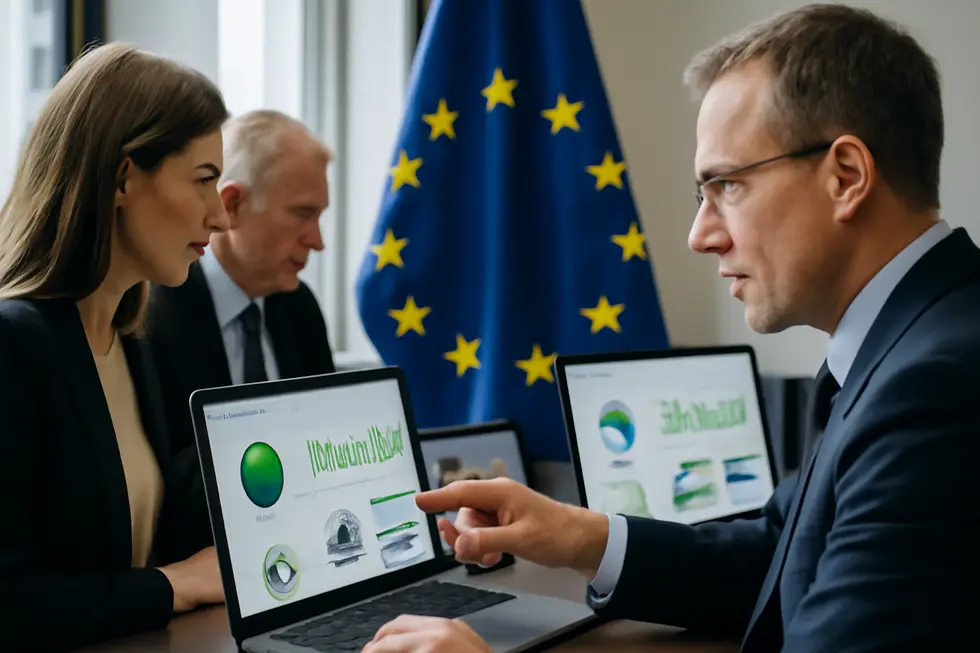Introdução
The evolving corporate landscape demands a deep understanding of how ‘corporate co’ entities—from SMEs to multinational giants—are embedding sustainability and responsibility into their core operations. This comprehensive exploration begins with HLM CORPORATE CO., LTD., a state-owned SME from Thailand demonstrating sustainability commitment through the UN Global Compact, setting a benchmark for smaller enterprises. The journey continues with ITOCHU Corporation, illustrating how global reach and diversified operations define multinational corporate co entities, and Panasonic Holdings Corporation, showcasing environmental initiatives critical in today’s business climate. A spotlight on the European Union’s Corporate Sustainability Reporting Directive (CSRD) reveals regulatory pressures driving transparency and accountability across corporate co. Finally, the Corporate Eco Forum highlights how collaboration among industry leaders fosters innovation and sustainable leadership. Together, these chapters provide business owners a clear and actionable roadmap for understanding and integrating sustainability within the corporate co framework.
Tabelas de conteúdos
Chapter 1: HLM CORPORATE CO: A Case Study in Corporate Co Sustainability Commitment
- Harnessing Technological Innovation: How HLM CORPORATE CO Advances Sustainable Operations
- Balancing Costs and Benefits: Economic Insights into HLM CORPORATE CO’s Sustainability Journey
- Balancing Regional Influence and Global Responsibility: The Societal and Geopolitical Dimensions of HLM CORPORATE CO’s Sustainability Pledge
Chapter 2: ITOCHU Corporation and Its Role as a Global Corporate Co Entity
- Strategic Innovation and Financial Discipline: The Driving Forces Behind ITOCHU’s Global Corporate Presence
- Embedding Sustainability in ITOCHU Corporation’s Global Corporate Strategy
- Strategic Global Growth and Collaborative Ventures Shaping ITOCHU’s Corporate Influence
Chapter 3: Panasonic Holdings Corporation: Corporate Co Initiatives in Environmental Sustainability
- Driving Environmental Leadership: Panasonic Holdings Corporation’s GREEN IMPACT Program and Circular Economy Innovation
- Panasonic’s Green Transformation Strategy and R&D: Driving Corporate Co Environmental Sustainability to Carbon Neutrality
- Holistic Sustainability in Panasonic’s Factory Operations, Product Innovation, and Supply Chain Strategies
Chapter 4: Corporate Co Compliance Under the European Union’s Corporate Sustainability Reporting Directive (CSRD)
- Unpacking ESG Disclosure Requirements under the EU’s Corporate Sustainability Reporting Directive
- Navigating Economic and Reporting Demands: Corporate Co Obligations Under the EU’s CSRD
- Overcoming Technological and Assurance Barriers in Corporate Co CSRD Compliance
Chapter 5: Corporate Eco Forum: A Platform for Corporate Co Leadership in Sustainability
- Forging Executive Alliances: How the Corporate Eco Forum Shapes Sustainability Leadership Among Corporate Co
- Driving Corporate Environmental Strategy Through Collaborative Leadership at the Corporate Eco Forum
- Fostering Collaborative Corporate Leadership for Sustainable Transformation
Chapter 1: HLM CORPORATE CO: A Case Study in Corporate Co Sustainability Commitment

1. Harnessing Technological Innovation: How HLM CORPORATE CO Advances Sustainable Operations
Technological innovation is at the heart of modern corporate sustainability strategies, and HLM CORPORATE CO exemplifies this integration by embedding cutting-edge technologies into its sustainability framework. Central to their approach is the use of advanced digital tools that optimize operational efficiency while minimizing environmental impact. For instance, digital twin technology allows the company to simulate building and process performance, enabling precise energy management and progress toward net-zero emissions. This digital replication not only reduces waste but also lowers costs, reflecting a strategic alignment of sustainability with financial prudence.
Beyond energy optimization, HLM CORPORATE CO leverages data analytics to track resource use across its supply chain. These insights drive initiatives to reduce waste and promote sustainable packaging, aligning product development with environmentally friendly standards. Such innovations echo broader industry trends where companies that embed sustainability into product design gain a competitive advantage by responding to rising consumer and regulatory demands.
Moreover, technological advancements stimulate green innovation by introducing and adapting environmental goods that foster eco-friendly processes. This dynamic encourages continuous improvement and propels HLM CORPORATE CO forward as a responsible corporate player. Public and stakeholder expectations reinforce this momentum, making transparency and innovation indispensable in the company’s sustainability journey.
This synergy of technology and sustainable practice places HLM CORPORATE CO within a global movement of corporate entities that leverage innovation to meet both ecological and operational goals. As the company navigates future sustainability challenges, its commitment to innovative solutions signals resilience and a proactive stance toward responsible business.
For further insight into how cutting-edge digital solutions elevate industry sustainability, see IESVE Sectors. Additionally, exploring guidance on copyrights and intellectual property can help companies protect their technological innovations while advancing sustainable practices.
2. Balancing Costs and Benefits: Economic Insights into HLM CORPORATE CO’s Sustainability Journey
HLM CORPORATE CO’s dedication to sustainability is intricately tied to its economic decision-making, illustrating how sustainability practices transcended moral imperative to become strategic business drivers. While sustainable initiatives initially bring heightened capital expenditures—such as investing in eco-friendly materials and training—these costs must be viewed in the broader context of long-term economic gains. By employing sophisticated approaches like Life Cycle Costing (LCC) integrated with Life Cycle Assessment (LCA), the company carefully assesses investments not only for environmental impact but also for cost-efficiency over assets’ entire lifespans. This method ensures decisions balance upfront spending with future savings.
A core example of HLM’s strategy lies in its collaboration with sustainable design experts who apply digital twin technology and advanced modeling to optimize building performance. These innovations help mitigate challenges like rising cooling demands due to temperature increases, thereby reducing energy consumption and enhancing whole-life carbon performance. Compliance with prevailing regulatory frameworks such as BREEAM Version 7 and the EU Taxonomy reinforces this alignment between economic and environmental objectives, allowing HLM to navigate evolving compliance landscapes with agility.
Economically, the short-term effect is an increase in initial costs, counterbalanced by diminished operational expenses as energy efficiency and asset resilience improve. Additionally, these sustainability commitments reduce exposure to risks such as regulatory penalties and energy price volatility, while elevating corporate reputation—an intangible yet impactful competitive advantage. Such strategic positioning may also open doors to financial incentives and market opportunities increasingly favoring environmentally responsible companies.
Ultimately, HLM CORPORATE CO exemplifies how integrating environmental responsibility into corporate frameworks is not solely an ethical mandate but an astute economic strategy. This holistic approach, supported by cutting-edge decision tools and regulatory awareness, helps transform sustainability from cost center to value creator.
For further insight into cost-effective sustainability measures in building projects, see the integration strategies discussed in Life Cycle Costing and Assessment integration strategies in sustainable building projects.
3. Balancing Regional Influence and Global Responsibility: The Societal and Geopolitical Dimensions of HLM CORPORATE CO’s Sustainability Pledge
HLM CORPORATE CO., LTD. stands at a pivotal junction where national interests and global sustainability goals intersect. As a state-owned SME in Thailand involved in multiple sectors, its formal commitment to the UN Global Compact since mid-2024 signals a growing awareness of its social and environmental responsibilities. Nonetheless, the company’s current non-communicating status highlights an early stage in its sustainability journey, reflecting limited public transparency in reporting progress as of mid-2025. This status underscores the challenge of translating pledges into actionable and measurable outcomes, a critical factor for enhancing trust among stakeholders and enabling meaningful societal impact.
The societal implications of this commitment revolve around the promotion of ethical governance, respect for human rights, adherence to fair labor standards, and proactive environmental stewardship within its operational sphere. Given its role as a state-owned enterprise, HLM CORPORATE CO. is uniquely positioned to influence local economies and communities in Thailand, fostering socioeconomic improvements that align with the United Nations Sustainable Development Goals. Its alignment with global principles serves not only as a corporate benchmark but also as a potential catalyst for raising industry standards throughout the region.
On the geopolitical stage, HLM CORPORATE CO.’s engagement embeds Thailand deeper into an international network dedicated to addressing pressing transnational challenges such as climate change, social inequality, and corruption. While the company’s current reporting limitations may diminish its immediate influence, progressing towards transparent and comprehensive disclosures will be vital for enhancing its credibility. Such advances could strengthen Thailand’s reputation as a responsible player in global markets and facilitate cross-border collaborations that promote regional sustainability initiatives.
In combining national significance with global sustainability frameworks, HLM CORPORATE CO. exemplifies the evolving role of corporate entities in bridging local development with international responsibility. Its future impact will depend heavily on its transition from commitment to demonstrated action and transparency. For the most current details on their sustainability status, the UN Global Compact participant profile of HLM CORPORATE CO., LTD. oferece informações valiosas.
This dimension of corporate responsibility complements broader industry trends and regulatory expectations, reinforcing the importance of integrating sustainable business practices into core strategies for enterprises of all scales, including those navigating intellectual property challenges and brand identity protection.
Chapter 2: ITOCHU Corporation and Its Role as a Global Corporate Co Entity

1. Strategic Innovation and Financial Discipline: The Driving Forces Behind ITOCHU’s Global Corporate Presence
ITOCHU Corporation exemplifies a unique blend of strategic financial discipline and forward-looking technological innovation that firmly establishes it as a major global corporate entity. Economically, the company’s disciplined capital allocation is a cornerstone of its robust performance. The notable ¥150 billion share buyback planned for 2025 is a strategic move to enhance shareholder value and demonstrate responsiveness to Japan’s evolving shareholder-centric corporate reforms. Alongside this, ITOCHU’s investment of approximately ¥1 trillion across diversified sectors underlines its commitment to sustainable growth. Maintaining an impressive return on equity around 15% confirms the company’s strong financial health and capacity to reinvest wisely.
On the technological front, ITOCHU actively leverages its extensive global networks to penetrate emerging markets and seize opportunities in novel business sectors. Its strategic alliance with a leader in auto finance focuses on the expanding used-car loan market across Japan and Asia, merging financial services with mobility-related innovations. This move reflects how ITOCHU aligns technology with shifting consumer demands driven by growing middle classes. Furthermore, the company’s expansion into licensing Japanese anime and character goods through international joint ventures illustrates its capacity to integrate cultural technology with global market expansion. This approach not only enhances brand reach but also diversifies business operations across continents.
Through these combined economic and technological strategies, ITOCHU acts as an astute investor, integrator, and facilitator of global trade, seamlessly balancing financial rigor with innovation. Its ability to connect diverse sectors—including finance, consumer products, and licensing—across borders underscores its pivotal role in global commerce. This multidimensional strategy positions ITOCHU to adapt and thrive amid the complexities of international markets, defining it as a dynamic and influential corporate co entity.
For deeper insights into how intellectual property and brand licensing support corporate growth strategies like ITOCHU’s, see this article on intellectual property rights.
Reference: [1], [3], [5]
2. Embedding Sustainability in ITOCHU Corporation’s Global Corporate Strategy
ITOCHU Corporation exemplifies how a global corporate entity can embed sustainability deeply within its business strategy, aligning operations with the United Nations Sustainable Development Goals (SDGs). Central to this commitment is its Group Sustainability Policy, which prioritizes addressing material social issues, cultivating trust with stakeholders, promoting sustainable supply chains, and enhancing employee sustainability education. Through its “Sustainability Action Guidelines for Supply Chains,” ITOCHU rigorously evaluates ESG risks by applying a comprehensive 30-point checklist and conducting on-site inspections, especially for suppliers with significant environmental or social impact. This proactive approach is supervised by the Sustainability Committee and regularly reported to the Board of Directors, reinforcing transparency and accountability.
In its pursuit of innovative solutions, ITOCHU spearheads green energy initiatives globally. A landmark partnership to develop a large-scale green ammonia plant in India embodies its drive to support clean maritime fuel alternatives and advance decarbonization efforts. Alongside this, ITOCHU actively promotes Sustainable Aviation Fuel adoption and engages in trading environmental value credits related to Scope 3 emissions, which reflect indirect greenhouse gases from its extended value chain. These efforts highlight the company’s dedication to building circular economies through cross-industry collaboration.
ITOCHU also champions broader sustainability themes such as gender equality and responsible procurement, exemplified by ethical sourcing policies for commodities like palm oil. By integrating ESG considerations into investment management and business activities, the corporation fosters enduring social value alongside economic growth. This holistic framework positions ITOCHU as a leading corporate citizen, demonstrating how multinational companies can blend innovation, responsibility, and transparency to address complex global challenges.
For an in-depth overview of ITOCHU’s sustainability efforts, refer to their detailed external review at this resource. Additionally, understanding trademark protection can be vital for corporate governance and branding; learn more about characteristics of copyright business.
3. Strategic Global Growth and Collaborative Ventures Shaping ITOCHU’s Corporate Influence
ITOCHU Corporation exemplifies a dynamic global corporate co entity through its deliberate expansion and strategic partnerships that span diverse industries and regions. Central to its international growth is the focus on leveraging cultural assets, notably the anime and character licensing business, which is actively promoted across Asia and North America. This expansion is highlighted by joint ventures such as the establishment of Rights & Brands Asia Ltd. in Hong Kong and the opening of a Shanghai branch, enabling ITOCHU to distribute Japanese content globally with localized strategies and expertise.
Beyond entertainment, ITOCHU demonstrates foresight in pioneering sustainable energy solutions, particularly in the maritime sector. Its Singapore-based subsidiary engages in developing ammonia bunkering vessels designed for low-emission marine fuel. Supported by Japan’s government, this initiative aims to commercialize ammonia fuel bunkering by 2027 at strategic global ports, including Singapore, Spain’s Strait of Gibraltar, Egypt’s Suez Canal, and Japan. This strategic move places ITOCHU at the nexus of innovative energy infrastructure and international trade flows.
Simultaneously, ITOCHU’s approach to asset management reveals agility, where sectors like textiles benefit from market-driven privatizations, enhancing profitability and resilience. The company’s embedded sustainability committees rigorously apply ESG criteria in supply chain oversight, strengthening governance and risk mitigation. These alliances and expansions reflect a complex strategy weaving traditional trading strengths with progressive, sustainability-focused initiatives.
This ability to integrate multifaceted operations and to collaborate globally underscores ITOCHU’s influential role as a corporate co entity. Its success illustrates how strategic partnerships and innovation-driven growth can align to navigate volatile markets and evolving global demands effectively. For more insights on ITOCHU’s anime licensing expansion, see their press release. To explore their energy ventures, consult this ammonia bunkering project overview.
Also, understanding intellectual property nuances is crucial for such licensing businesses; more details can be found in the article on caraterísticas do direito de autor.
Chapter 3: Panasonic Holdings Corporation: Corporate Co Initiatives in Environmental Sustainability

1. Driving Environmental Leadership: Panasonic Holdings Corporation’s GREEN IMPACT Program and Circular Economy Innovation
Panasonic Holdings Corporation exemplifies a committed corporate co that integrates sustainability deeply into its global operations through its flagship GREEN IMPACT program. This initiative reflects Panasonic’s strategic ambition to drastically reduce greenhouse gas emissions by targeting a 93 million tonne CO₂ cut by 2031, alongside a longer-term goal of net-zero in-house emissions by 2030 and a 300 million tonne reduction by 2050. Achieving these targets relies on concrete actions such as operating 44 zero-CO₂ factories and using nearly 30,000 tons of recycled resin in manufacturing processes, underscoring Panasonic’s dedication to minimizing environmental impact throughout its value chain.
The program’s robust circular economy efforts further amplify Panasonic’s environmental leadership. The “Factory Refresh” initiative refurbishes tens of thousands of home appliances annually at its Utsunomiya facility, extending product lifecycles and significantly reducing waste. By emphasizing refurbishment, Panasonic not only promotes resource efficiency but also models sustainable product stewardship, fostering a shift away from linear consumption patterns prevalent in the electronics sector.
Technological innovation underpins these efforts, as Panasonic’s Technology Division aggressively pursues advancements in water conservation, energy, food sustainability, and carbon neutrality. Their “Technology Future Vision” aims to create social systems supportive of sustainability while collaborating with external experts to shape broader environmental impact. This comprehensive approach—melding operational improvements, circular economy principles, and forward-looking R&D—positions Panasonic as a pioneering corporate co actively transforming its business to align with global sustainability imperatives.
Such initiatives highlight how large corporations embed responsibility into their core strategies, balancing economic success with ecological stewardship. For businesses seeking to understand the nexus of technology, sustainability, and corporate governance, Panasonic’s GREEN IMPACT program serves as a compelling model.
For more on sustainable business frameworks shaping corporate responsibilities, explore texto de direitos de autor para o sítio web.
Source: Panasonic EV Battery Plant
2. Panasonic’s Green Transformation Strategy and R&D: Driving Corporate Co Environmental Sustainability to Carbon Neutrality
Panasonic Holdings Corporation demonstrates a decisive commitment to environmental sustainability through its innovative Green Transformation (GX) strategy. This strategy is integral to its corporate growth and innovation, aligning closely with the broader objectives of corporate co initiatives addressing climate change and resource conservation. Central to Panasonic’s GX is the pursuit of carbon neutrality while fostering nature-positive solutions—an ambition realized by embedding sustainability into core research and development activities.
The GX strategy focuses on multiple critical domains, including renewable energy, sustainable agriculture, carbon footprint reduction, and circular economy advancement. Panasonic’s Technology Division has spotlighted this approach as a cornerstone of its future vision, emphasizing breakthroughs like solar glass panels that serve dual roles as power generators and building materials. Complementing this are innovations in biodegradable marine materials and biostimulants that elevate crop yields while reducing chemical dependency, thereby mitigating environmental impacts holistically.
Investment in R&D enhances these efforts, producing eco-friendly materials and urban-optimized renewable technologies. Panasonic’s environmental leadership has earned esteemed industry recognition, reinforcing the efficacy of its sustainability programs. Operationalizing GX, the GREEN IMPACT program targets significant CO2 emission reductions through manufacturing improvements, recycling optimization, and product longevity enhancement. Achievements such as operating numerous zero-emission factories and maintaining near-perfect waste recycling rates exemplify Panasonic’s integrated sustainability measures.
Further supporting corporate co responsibility, Panasonic’s electric vehicle battery plants are designed with supply chain sustainability in mind, emphasizing local sourcing to minimize emissions and improve environmental accountability. This approach anticipates reducing millions of tons of CO2 emissions by 2031, underscoring Panasonic’s holistic environmental strategy.
Through the fusion of visionary GX strategy and dedicated R&D innovation, Panasonic leads in embedding sustainability into its operations and products. This creates a robust framework for continued technological progress, environmental stewardship, and corporate responsibility essential to the evolving landscape of global corporate sustainability.
For more on Panasonic’s technological innovations and GX strategy, see their Technology Future Vision. Additionally, explore insights on how to choose a unique and effective corporate name in sustainability branding at use-business-name-existing.
3. Holistic Sustainability in Panasonic’s Factory Operations, Product Innovation, and Supply Chain Strategies
Panasonic Holdings Corporation exemplifies a commitment to environmental sustainability through its integrated approach deployed across factory operations, product innovation, and supply chain management. Central to this is the global Panasonic GREEN IMPACT program, which targets a substantial reduction of 93 million tonnes of CO₂ emissions by 2031. This ambitious vision is reflected in the company’s 44 zero-CO₂ factories, showcasing cutting-edge manufacturing processes that embrace a circular economy ethos. Achieving a 99.3% factory waste recycling rate and incorporating large volumes of recycled resin—29,600 tons—illustrates Panasonic’s dedication to minimizing environmental footprint while maximizing resource efficiency.
In product innovation, the focus is on longevity and recyclability, applying eco-conscious design principles that extend product lifespan and reduce waste. By innovating with biodegradable materials—particularly resins blended with plant-based cellulose fibers engineered for marine environments—Panasonic pioneers solutions that address ecosystem impacts beyond manufacturing. This technology recently earned the prestigious Ichimura Prize against Global Warming, recognizing advancement in mitigating climate change through material science.
Equally significant is Panasonic’s emphasis on sustainable supply chain management. Strategically sourcing locally, especially for EV battery production, reduces transportation emissions and boosts regional economies. This approach not only advances CO₂ reduction goals under GREEN IMPACT but also fosters innovation by enhancing supply chain resilience and adaptability.
Beyond direct operations, Panasonic’s Technology Division prioritizes research that underpins the Green Transformation (GX), tackling critical global challenges such as water and food security through renewable urban infrastructure innovations, including solar glass panels integrated into buildings. These collective efforts demonstrate Panasonic’s focused integration of environmental sustainability deep into its corporate DNA, linking manufacturing innovation, eco-conscious product cycles, and responsible sourcing to achieve broad climate goals.
For deeper insight into Panasonic’s technological advances fueling sustainability, see Technology innovations for sustainability. Additionally, businesses structuring sustainable brand identities may find value in this guide on characteristics of copyright business, which reinforces the importance of intellectual property stewardship amid evolving corporate responsibility.
Chapter 4: Corporate Co Compliance Under the European Union’s Corporate Sustainability Reporting Directive (CSRD)

1. Unpacking ESG Disclosure Requirements under the EU’s Corporate Sustainability Reporting Directive
The Corporate Sustainability Reporting Directive (CSRD) represents a transformative framework reshaping how corporate entities disclose Environmental, Social, and Governance (ESG) data across the European Union. Escalating beyond its predecessor, the Non-Financial Reporting Directive, the CSRD vastly broadens the number and scale of companies required to submit detailed sustainability reports. This directive mandates adherence to the European Sustainability Reporting Standards (ESRS), which encompass a rigorous set of criteria designed to ensure ESG disclosures are consistent, comparable, and decision-useful for stakeholders.
At its core, the CSRD enforces a “double materiality” assessment. This approach compels companies to evaluate not only how sustainability matters impact their financial performance but also how their operations affect people and the planet. By focusing on issues most pertinent to each company’s unique business model, disclosures become far more tailored and relevant than previous checklist-oriented standards.
The directive imposes staged compliance deadlines, beginning in 2024 for the largest corporations and extending to all listed and sizeable enterprises by 2026. It anticipates over 71,000 companies within its scope, significantly amplifying transparency demands. To accommodate this extensive coverage, ESRS standards are actively being refined to reduce detailed data points by more than half while aligning with international reporting frameworks such as the ISSB’s IFRS S1 and S2. This harmonization promotes global ESG data interoperability and alleviates duplication burdens.
Additionally, the CSRD’s evolving threshold proposals could raise employee and revenue limits, potentially narrowing immediate obligations but maintaining the directive’s overarching ambition to embed sustainability deeply into corporate compliance culture. The regulation functions synergistically with the EU Green Deal, the EU Taxonomy, and the Sustainable Finance Disclosure Regulation to mobilize capital flows toward sustainable business models.
By mandating comprehensive ESG disclosure under standardized criteria, the CSRD elevates corporate responsibility and accountability across diverse sectors. It compels modern corporate companies to integrate ESG considerations not only as compliance exercises but as essential elements shaping their strategic and operational futures.
For a detailed understanding of the CSRD’s scope and reporting requirements, visit the official resource: https://eur-lex.europa.eu/legal-content/EN/TXT/?uri=CELEX%3A32022L2464
Learn more about protecting intellectual property and brand identity which aligns with responsible corporate practices at texto de direitos de autor para o sítio web.
2. Navigating Economic and Reporting Demands: Corporate Co Obligations Under the EU’s CSRD
The Corporate Sustainability Reporting Directive (CSRD) represents a transformative shift for companies operating within the European Union, embedding sustainability deeply into corporate governance and financial disclosures. Unlike its predecessor, the Non-Financial Reporting Directive (NFRD), the CSRD broadens its scope, applying to all large companies, listed entities, and firms with significant EU turnover. This widening catchment imposes a rigorous regulatory framework grounded in the principle of double materiality, requiring companies to disclose not only how sustainability impacts their financial health but also how their activities affect environmental and social systems.
Economically, this dual focus amplifies compliance complexity and cost structures. Firms must rigorously collect, verify, and report Environmental, Social, and Governance (ESG) data aligned with the stringent European Sustainability Reporting Standards (ESRS). These standards extend beyond traditional financial metrics, encompassing detailed disclosures on biodiversity, water management, social performance, and governance practices. This shift mandates greater operational transparency accompanied by external assurance to validate reported sustainability information, thereby increasing auditing and procedural overhead.
Beyond compliance costs, the CSRD enhances data quality and comparability, fostering more informed capital allocation by investors intent on sustainable finance. The directive’s phased implementation—starting with the largest entities in 2024—gives companies a structured timeline to embed these comprehensive reporting practices. Integral to the process is the double materiality assessment, which compels corporate entities to evaluate sustainability risks and opportunities along their entire value chains while engaging stakeholders to ensure transparency and accountability.
These evolving obligations require corporate companies to rethink their strategic planning to integrate sustainability not as an afterthought but as a core lens for decision-making. The directive paves the way for harmonized reporting practices across the EU, driving a new era of corporate responsibility focused on measurable impact and enhanced stakeholder trust.
For a detailed analysis of the CSRD’s evolving landscape and its obligations, please refer to SWEEP’s comprehensive overview.
In understanding these challenges, companies may also find value in insights about intellectual property and business identity management to complement their compliance strategy, as outlined in resources like texto de direitos de autor para o sítio web.
3. Overcoming Technological and Assurance Barriers in Corporate Co CSRD Compliance
The journey toward compliance with the European Union’s Corporate Sustainability Reporting Directive (CSRD) presents significant technological and assurance challenges for corporate entities. A core technological hurdle lies in managing vast volumes of Environmental, Social, and Governance (ESG) data while ensuring its quality, accuracy, and traceability within robust data governance frameworks. This complexity is intensified by the CSRD’s requirement for double materiality assessments, demanding companies to evaluate both how ESG issues affect financial performance and how business activities impact society and the environment, often necessitating collaboration across diverse departments.
Further complicating compliance, firms must align their financial and operational disclosures with the EU Taxonomy’s detailed classification of sustainable economic activities. Managing such intricate data requires deploying emerging technologies, including AI-driven analytics to automate data gathering and anomaly detection, blockchain systems to enhance supply chain transparency, and centralized platforms that provide real-time monitoring of key sustainability metrics like Scope 3 emissions. These technological investments not only streamline data management but also lay the groundwork for generating the detailed, audit-ready sustainability reports the CSRD mandates.
On the assurance front, CSRD introduces a progressive verification regimen. From 2025, companies must secure limited assurance on their sustainability reports, advancing toward reasonable assurance by 2028. This evolution requires auditors to acquire specialized qualifications under EU auditing directives, aligning their expertise with emerging sustainability standards. Additionally, variations across EU member states in applying assurance frameworks add layers of complexity, particularly for multinational corporate co entities. Establishing internal controls for sustainability data akin to those in financial audits becomes critical to manage both cost and compliance risks.
Many companies still operate with fragmented ESG reporting infrastructures lacking integration across global supply chains, highlighting the organizational challenge to coordinate IT, legal, finance, procurement, and sustainability teams into cross-functional CSRD task forces. Proactive strategies, including early double materiality assessments, developing scalable ESG data systems, internal training, and pilot reporting exercises, are essential to prevent bottlenecks and reduce compliance costs.
Together, these technological and assurance capacities form the backbone of effective CSRD compliance, fostering transparency and accountability within corporate co operations. For a deeper understanding of building structured internal frameworks supporting such compliance, see this resource on texto de direitos de autor para o sítio web.
For comprehensive details on the evolving assurance expectations under CSRD, refer to the EU Commission’s official CSRD guidance: https://commission.europa.eu/business-economy-euro/company-reporting-and-auditing/company-reporting/corporate-sustainability-reporting_en
Chapter 5: Corporate Eco Forum: A Platform for Corporate Co Leadership in Sustainability

1. Forging Executive Alliances: How the Corporate Eco Forum Shapes Sustainability Leadership Among Corporate Co
The Corporate Eco Forum (CEF) stands as a pivotal nexus where senior executives from the world’s largest and most influential corporations converge to champion sustainability as a foundational business imperative. This invitation-only community gathers leaders from diverse sectors representing a staggering $5.5 trillion in combined revenues, illustrating the forum’s unparalleled reach and economic significance.
CEF’s core strength lies in its capacity to cultivate collaborative executive networks that facilitate deep, candid engagement on sustainability issues. By providing a trusted and neutral environment, the forum enables executives to share strategic insights, innovative practices, and real-world challenges without competitive constraints. This openness fosters accelerated learning and enables participating companies to integrate sustainability more effectively and authentically into their core operations.
Annual flagship events like the Leadership Retreat are instrumental in driving forward-thinking dialogue. These convenings highlight pioneering approaches and emerging trends, equipping leaders to address environmental, social, and governance challenges with a united, informed front. Complementing events, the forum’s Weekly Briefing distills critical sustainability news and research into actionable intelligence, ensuring members remain at the forefront of corporate responsibility.
Recognition initiatives, such as the Prahalad Award, spotlight transformational leadership that intertwines sustainability with business success, motivating continuous innovation. Through these multi-faceted efforts, CEF does more than just connect executives—it energizes a co-leadership model that propels collective progress toward a sustainable economy.
By fostering a vibrant network of executive collaboration, the Corporate Eco Forum exemplifies how strategic alliances among corporate co can accelerate sustainability ambitions and translate them into tangible, large-scale impact. For more information on the forum’s mission and activities, visit the Corporate Eco Forum website.
2. Driving Corporate Environmental Strategy Through Collaborative Leadership at the Corporate Eco Forum
The Corporate Eco Forum (CEF) serves as a vital collaborative platform where senior executives from leading global companies unite to advance sustainability within core business strategies. Unlike isolated corporate social responsibility programs, CEF promotes a deep integration of environmental objectives with financial and operational goals. This collective leadership approach accelerates the translation of sustainability ambitions into clear, actionable priorities embedded across diverse departments.
By facilitating open exchanges of best practices, coordinated initiatives, and aligned performance metrics, the forum enables members to innovate in areas such as supply chain transformation, emissions reduction, resource efficiency, and workforce engagement. This environment encourages firms to craft sustainability targets that are measurable and linked directly to their long-term value creation, echoing strategic frameworks like those seen in multinational corporations worldwide.
Moreover, the forum’s emphasis on collective action strengthens members’ ability to respond effectively to evolving Environmental, Social, and Governance (ESG) demands, creating a competitive advantage grounded in responsibility and transparency. This paradigm underscores a broader shift in corporate governance, where sustainability is no longer a peripheral compliance issue but a strategic imperative that drives operational excellence and stakeholder trust.
CEF exemplifies how cooperative leadership among diverse corporate entities fosters innovation and accountability, helping companies meet ambitious climate goals and resource stewardship commitments. By creating a shared space for dialogue and collaboration, the forum accelerates sustainable business transformation across industries.
For those interested in unpacking the strategic levers managers use to drive sustainable transformations within such collaborative platforms, further insights can be found through this detailed resource.
3. Fostering Collaborative Corporate Leadership for Sustainable Transformation
The Corporate Eco Forum (CEF) stands as a vital nexus for senior executives from leading corporate entities dedicated to advancing sustainability at the highest levels of decision-making. By convening these leaders, CEF cultivates a collaborative environment where companies exchange innovative approaches to embed Environmental, Social, and Governance (ESG) criteria within their core strategies. This peer-driven network amplifies efforts to move beyond compliance, focusing instead on transformative actions that align profitability with environmental stewardship and social responsibility.
Through platforms like CEF, corporations integrate sustainability Key Performance Indicators (KPIs) directly into executive incentives, thereby linking leadership accountability to measurable environmental and social outcomes. Utilizing methodologies such as carbon accounting and life cycle assessments, members rigorously evaluate impacts, identify reduction opportunities, and strategize sustainable innovations. Circular economy principles are also championed, encouraging waste minimization and value retention across product lifecycles, which fosters resilience and long-term business viability.
CEF’s collaborative ethos mirrors broader global initiatives like the United Nations Global Compact, promoting multi-stakeholder partnerships to address urgent climate challenges. This peer network inspires senior leaders to embrace systemic change, harmonizing business growth with ethical governance and transparency. While discreet on specific programs, the forum’s collective influence drives corporate sustainability leadership forward by sharing best practices and championing accountability frameworks.
Managers seeking to orchestrate effective sustainable business transformations can look to strategic levers emphasized within CEF’s discourse, including innovation adoption, performance integration, and cross-sector cooperation. These strategic pathways underscore how corporate entities can embed sustainability deeply into their operations and culture, paving the way for resilient economies and responsible corporate citizenship. For a deeper exploration of these strategies and how they empower corporate sustainability, see this insightful resource.
Integrating sustainability into executive leadership not only ensures alignment with evolving regulatory landscapes but also equips companies to thrive in a market increasingly valuing ethical and ecological responsibility.
Considerações finais
The landscape of corporate co is deeply intertwined with sustainability, global responsibility, and evolving governance frameworks. From the focused sustainability commitment of HLM CORPORATE CO., LTD. to the expansive global operations of ITOCHU Corporation, and Panasonic Holdings Corporation’s environmental initiatives, it is clear that corporate co entities are redefining business success beyond mere profit. Compliance frameworks like the EU’s CSRD further institutionalize accountability, while platforms like the Corporate Eco Forum elevate leadership and innovation in sustainability. For business owners, understanding these dimensions of corporate co equips them to navigate challenges, comply with emerging standards, and compete in a future economy where responsible practices are paramount. Embracing this holistic view is not only essential—it’s strategic for ongoing growth and resilience.
Obtenha a sua marca registada hoje! Milhares de pessoas protegeram a sua marca através do registo de uma marca registada. De que está à espera? Inicie o seu pedido de registo de marca!
Sobre nós
The globe’s top website for registering trademarks and safeguarding your brand, name, logo, or slogan.







